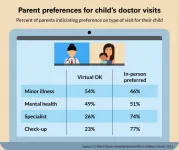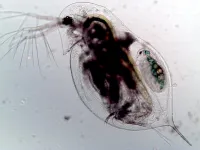DALLAS, May 17, 2021 -- Detecting a critical heart defect before birth (congenital heart defects) is less likely when a mother lives in a rural area, lives in a neighborhood with low socioeconomic status or is Hispanic, according to new research published today in the American Heart Association's flagship journal Circulation.
Diagnosing a heart defect before birth reduces infant death rates, increases access to prompt medical treatment, improves neurodevelopmental outcomes and decreases the risk of brain injury for the infant after birth.
"The benefits of prenatal diagnosis for heart defects have been recognized for years, yet prenatal detection occurs in less than 60% of congenital heart disease cases in many U.S. regions," said the study's first author Anita Krishnan, M.D., an associate professor of pediatrics and associate director of echocardiography at Children's National Hospital in Washington, D.C.
"This is one of the largest studies to define specific populations at risk for missed prenatal screening and diagnosis of congenital heart disease," she said. "With these conditions, minutes can make a difference, and prenatal planning allows for improved care before, during and after birth."
Researchers evaluated data on more than 1,800 infants from 21 cardiology centers in the United States and Canada to determine whether a relationship exists between prenatal detection of transposition of the great arteries and hypoplastic left heart syndrome and socioeconomic, racial/ethnic and geographic factors.
Congenital heart defects are heart conditions present at birth. According to the American Heart Association's Heart Disease and Stroke Statistics -- 2021 Update, an estimated minimum of 40,000 infants are expected to be affected each year by congenital heart defects in the United States. At least 18 distinct types of congenital heart defects are recognized, with many additional anatomic variations.
Transposition of the great arteries occurs when the two main arteries leaving the heart are reversed and accounts for 2.6% of congenital heart defects. Hypoplastic left heart syndrome involves an underdeveloped left side of the heart and accounts for about 0.3% of the defects.
The study focused on clinical data from fetuses and infants with a first-time evaluation between 2012 and 2016 at a participating institution in the Fetal Heart Society, a non-profit multicenter research collaborative whose mission is to advance the field of fetal cardiovascular care and science. Researchers defined prenatal detection as having a fetal echocardiogram - a test that uses high frequency sound waves, or ultrasound, to view structures and functioning of the fetus' heart. Patients are referred for fetal echocardiograms for a variety of maternal or fetal conditions per the guidelines from the American Institute of Ultrasound in Medicine, or if an anomaly is suspected on a second trimester ultrasound examination. Most cases are referred due to suspected cardiac disease and not for one of the routine indications for fetal echocardiography, Krishnan explained.
Hypoplastic left heart syndrome is identifiable through echocardiogram imaging of the heart's four chambers; however, detecting transposition of the great arteries requires additional views on prenatal ultrasound screening and may be more difficult to detect prenatally than hypoplastic left heart syndrome, the authors noted.
Socioeconomic and residential information came from federal census data for the mothers, and distance from a cardiology center was derived from the mothers' address at the time of her first visit for prenatal detection. For U.S. patients, socioeconomic neighborhood status was measured in quartiles that considered median household income; median household value; neighborhood percentage of high school graduates; neighborhood percentage of college graduates; percentage of neighborhood residents in executive, managerial or professional specialty occupations; and the percentage of households receiving rental income.
Among Canadian patients - all from Alberta and Ontario - socioeconomic status was calculated from 22 variables related to cultural identities, environmental pollutants, environmental injustice studies and a deprivation index, which is a marker of social inequalities in health. These factors were then converted to be comparable with the U.S. quartiles.
The study revealed that about 92% of hypoplastic left heart syndrome cases and 58% of transposition of the great arteries cases were diagnosed before birth. However, significant socioeconomic and racial and ethnic differences emerged among the women diagnosed with fetal transposition of the great arteries.
"Mothers who lived in neighborhoods with the lowest socioeconomic position were up to 22% less likely to receive a prenatal diagnosis of transposition of the great arteries than the mothers who lived in the wealthiest neighborhoods," Krishnan said. "While the findings are not completely surprising and resonate with clinical experience, the strength of the associations was surprising."
Other findings include:
Hispanic ethnicity in the United States was associated with a 15% lower likelihood of prenatal detection of transposition of the great arteries compared to non-Hispanic mothers, and living in rural areas was associated with a 22% lower likelihood of prenatal detection of transposition of the great arteries compared to mothers who lived in more urban areas. Among the patients in Canada, only longer distance to a cardiology center was associated with lower prenatal detection rates of hypoplastic left heart syndrome - those driving more than 135 miles for care were 24% less likely to have transposition of the great arteries detected. Lower socioeconomic status was associated with about a four-week delay in diagnosing prenatal congenital heart disease for pregnant women in both the U.S. and Canada. The standards of care for congenital heart disease are similar in both countries, yet some of the associations were different in the United States compared to Canada, where health care is publicly funded and available to all Canadian citizens or permanent residents without financial limitations. "This suggests that factors related to the different health care delivery systems may also play a role in the rates of screening and diagnosis," Krishnan said.
"While prenatal detection rates of congenital heart disease are lower than they should be across the board, there are striking sociodemographic and geographic disparities," she said. "Strengthening relationships among cardiology and surgery centers and the populations identified in this study, through outreach and potentially telemedicine, may improve prenatal detection rates within these communities.
"Telehealth linkages to the tertiary care center may improve timeliness of detection as well as overall detection rates, but is likely not the only solution," Krishnan continued. "In-person collaboration or consultation is also needed. There is ongoing study of whether socioeconomic barriers exist to participation with telemedicine and internet, and our center is currently doing pilot work in rural Maryland. To successfully implement telemedicine requires investing in the hardware, educating sonographers and establishing the security infrastructure to make telemedicine easier to perform."
The study created a new registry of data variables that had not been possible using hospital databases that typically do not include prenatal care information linking maternal and pediatric records. A significant limitation is that the study only included patients who received care at one of the 21 participating fetal cardiology centers.
INFORMATION:
Co-authors are Marni B. Jacobs, Ph.D.; Shaine A. Morris, M.D., M.P.H.; Shabnam Peyvandi, M.D.; Aarti H. Bhat, M.D.; Anjali Chelliah, M.D.; Joanne S. Chiu, M.D.; Bettina F. Cuneo, M.D.; Grace Freire, M.D.; Lisa K. Hornberger, M.D.; Lisa Howley, M.D.; Nazia Husain, M.D.; Catherine Ikemba, M.D.; Ann Kavanaugh-McHugh, M.D.; Shelby Kutty, M.D., Ph.D., M.H.C.M.; Caroline Lee, M.D.; Keila N. Lopez, M.D., M.P.H.; Angela McBrien, M.D.; Erik C. Michelfelder, M.D.; Nelangi M. Pinto, M.D.; Rachel Schwartz, M.D.; Kenan W.D. Stern, M.D.; Carolyn Taylor, M.D.; Varsha Thakur, M.D.; Wayne Tworetzky, M.D.; Carol Wittlieb-Weber, M.D.; Kristal Woldu, M.D.; and Mary T. Donofrio, M.D.
The study was funded by the National Institute on Minority Health and Health Disparities of the National Institutes of Health, the Children's National Heart Institute Cardiology Patient Research Fund and the Fetal Heart Society.
Additional Resources:
Available multimedia is on right column of release link - https://newsroom.heart.org/news/prenatal-detection-of-heart-defects-lower-in-rural-poor-areas-and-among-hispanic-women?preview=be432ecc3b6275f956337de3b374e2eb
Statements and conclusions of studies published in the American Heart Association's scientific journals are solely those of the study authors and do not necessarily reflect the Association's policy or position. The Association makes no representation or guarantee as to their accuracy or reliability. The Association receives funding primarily from individuals; foundations and corporations (including pharmaceutical, device manufacturers and other companies) also make donations and fund specific Association programs and events. The Association has strict policies to prevent these relationships from influencing the science content. Revenues from pharmaceutical and biotech companies, device manufacturers and health insurance providers are available here, and the Association's overall financial information is available here.
About the American Heart Association
The American Heart Association is a relentless force for a world of longer, healthier lives. We are dedicated to ensuring equitable health in all communities. Through collaboration with numerous organizations, and powered by millions of volunteers, we fund innovative research, advocate for the public's health and share lifesaving resources. The Dallas-based organization has been a leading source of health information for nearly a century. Connect with us on heart.org, Facebook, Twitter or by calling 1-800-AHA-USA1.




